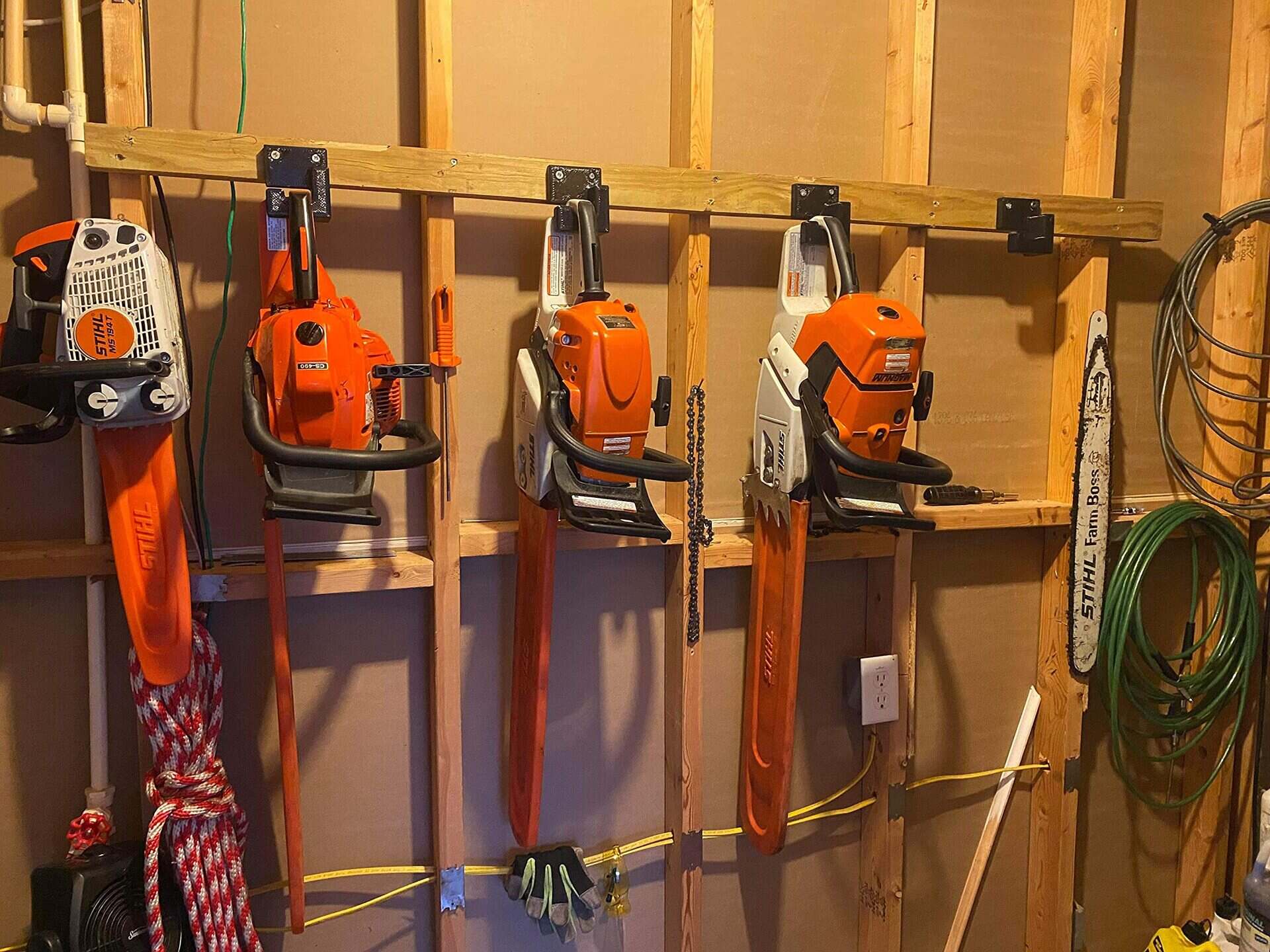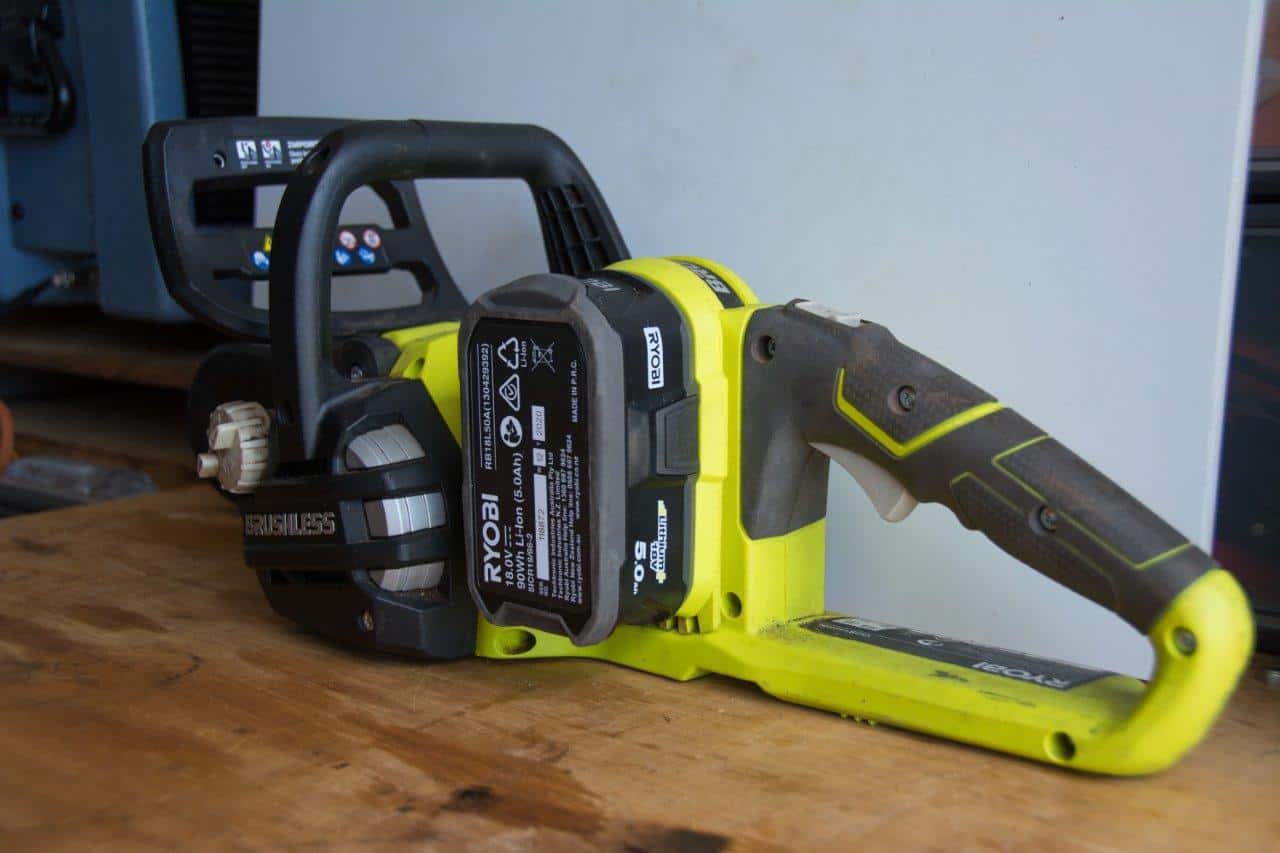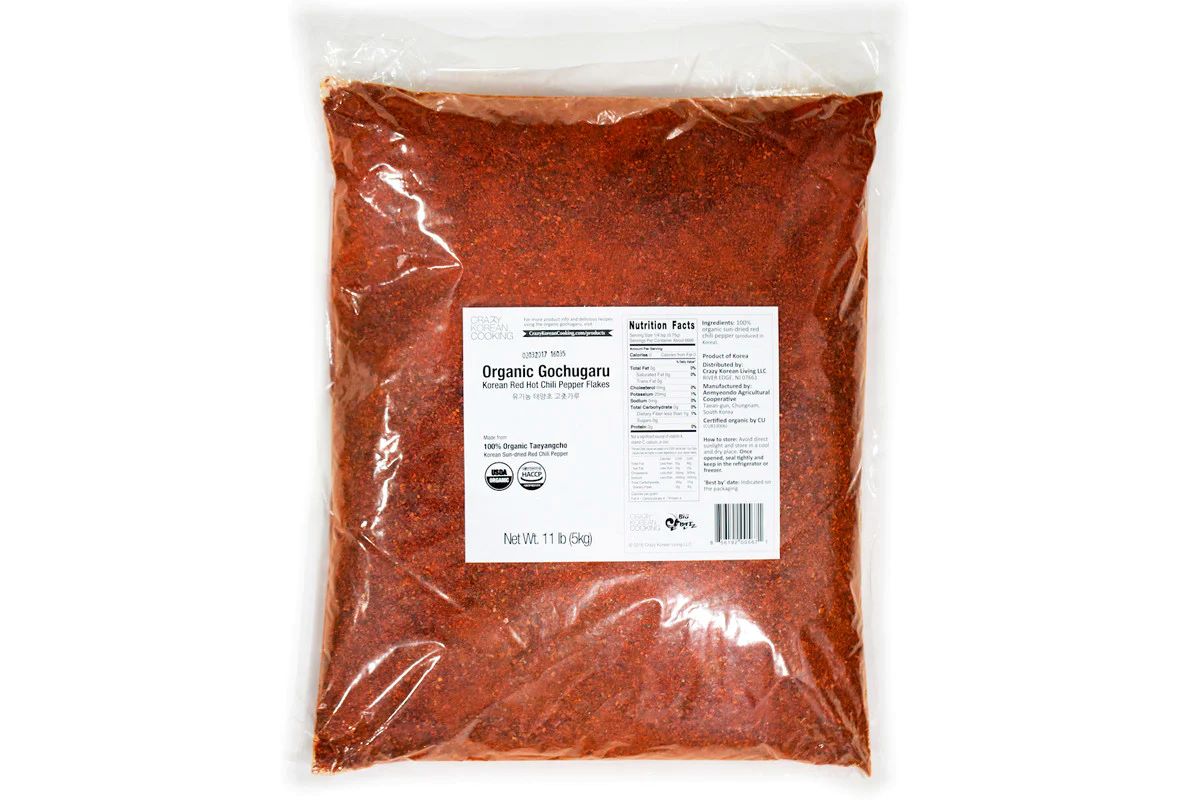

Articles
How To Store Chainsaw
Modified: January 6, 2024
Learn the best methods for storing your chainsaw and keeping it in optimal condition with our informative articles.
(Many of the links in this article redirect to a specific reviewed product. Your purchase of these products through affiliate links helps to generate commission for Storables.com, at no extra cost. Learn more)
Introduction
Welcome to our guide on how to properly store a chainsaw. Whether you’re a professional logger or a weekend warrior tackling occasional outdoor projects, proper storage is essential to keep your chainsaw in top condition and extend its lifespan. By following the right steps for storage, you can minimize the risk of damage and ensure that your chainsaw is ready for use whenever you need it.
A chainsaw is a powerful and versatile tool that requires regular maintenance to keep it performing at its best. Proper storage goes beyond simply putting it away in a corner of your garage or shed. You need to consider factors such as the storage location, cleaning and preparation, fuel and oil drainage, blade maintenance, lubrication, and more.
In this article, we will guide you through each step of the process, providing valuable insights and tips to help you properly store your chainsaw. By following these guidelines, you can prevent rust, corrosion, and other issues that may arise with improper storage.
Before we dive into the specific steps involved in storing a chainsaw, let’s first discuss the importance of choosing the right storage location.
Key Takeaways:
- Properly storing your chainsaw is crucial for maintaining its performance and longevity. Choose a dry, secure location, clean and prepare the chainsaw, drain fuel and oil, remove the spark plug, maintain the blade, lubricate, and cover it to ensure optimal condition for future use.
- Regularly inspect and maintain your stored chainsaw to prevent issues. Follow manufacturer’s guidelines, consider professional servicing, label and organize accessories, and maintain proper ventilation in the storage area. These steps will enhance the longevity and performance of your chainsaw during storage.
Read more: How To Store Chainsaws In Garage
Choosing the Right Storage Location
When it comes to storing your chainsaw, the first consideration is finding the right location. Ideally, you want a space that is dry, well-ventilated, and secure. Here are some factors to keep in mind:
- Dryness: Moisture is the enemy of metal tools, including chainsaws. It can cause rust and corrosion, which can be detrimental to the performance and lifespan of your chainsaw. Look for a storage location that is dry and away from sources of water such as leaky roofs or windows.
- Ventilation: Proper ventilation is crucial to prevent the build-up of fumes and moisture. Avoid storing your chainsaw in a tightly sealed container or a location with poor air circulation. This can lead to condensation and promote the growth of mold and mildew.
- Temperature: Extreme temperatures can also affect the performance of your chainsaw. Avoid storing it in areas that are prone to temperature fluctuations, such as unheated sheds or garages. Opt for a storage location with a moderate and consistent temperature.
- Security: Chainsaws are valuable tools and can be targets for theft. Consider a storage location that offers adequate security measures, such as lockable cabinets, sheds, or garages. This will help protect your investment and give you peace of mind.
- Accessibility: While proper storage is essential, you also want your chainsaw to be easily accessible when needed. Choose a location that is convenient for you to retrieve and return your chainsaw without hassle.
By carefully selecting the right storage location, you can ensure that your chainsaw is protected from environmental factors and minimize the risk of damage or deterioration.
Cleaning and Preparing the Chainsaw
Before storing your chainsaw, it’s important to clean and prepare it properly. This will help remove any dirt, debris, or residue that may have accumulated during use, ensuring that your chainsaw is in optimal condition for storage. Here’s how to clean and prepare your chainsaw:
- Remove debris: Start by using a brush or compressed air to remove any debris, sawdust, or dirt from the chainsaw. Pay close attention to the chain, guide bar, and air filter, as these are the areas most prone to buildup.
- Inspect for damage: Take this opportunity to inspect your chainsaw for any signs of wear or damage. Look for loose or worn parts, cracks in the housing, or damage to the guide bar. Address any necessary repairs or replacements before storing the chainsaw.
- Clean the chain: Next, clean the chain using a chain cleaner or a mixture of warm water and mild soap. Use a brush or toothbrush to scrub away any built-up sawdust or residue. Rinse the chain thoroughly and dry it completely before proceeding.
- Check the air filter: The air filter plays a crucial role in keeping your chainsaw’s engine running smoothly. Remove the air filter and inspect it for dirt or clogs. If it’s dirty, clean it according to the manufacturer’s instructions or replace it if needed.
- Sharpen the chain: While not necessary for storage, it’s a good idea to sharpen the chain before putting your chainsaw away. A sharp chain will ensure better cutting performance and prolong the life of your chainsaw. If you’re not comfortable sharpening the chain yourself, consider taking it to a professional.
By thoroughly cleaning and preparing your chainsaw, you can remove any potential hazards or contaminants and ensure that it’s in prime condition for storage. This will also make it easier to inspect and maintain the chainsaw when you take it out of storage.
Draining Fuel and Oil
Before storing your chainsaw, it’s important to drain the fuel and oil from the tank. Leaving fuel and oil in the chainsaw for an extended period can lead to clogs, varnish buildup, and potential damage to the engine. Follow these steps to properly drain the fuel and oil:
- Run the chainsaw: Start by running the chainsaw until it runs out of fuel. This helps ensure that the fuel system is empty and reduces the chances of any remaining fuel causing issues during storage.
- Empty the fuel tank: Once the chainsaw has run out of fuel, remove the fuel cap, and carefully empty any remaining fuel into an approved container. Avoid spilling fuel on the chainsaw or surrounding area to prevent potential fire hazards.
- Drain the oil: In addition to fuel, it’s also important to drain the oil from the chainsaw. This prevents oil from leaking and potentially damaging the engine or other components. Refer to your chainsaw’s user manual to locate the oil drain plug and carefully remove it to drain the oil completely.
- Dispose of fuel and oil: Properly dispose of the drained fuel and oil in accordance with local regulations. Most areas have specific guidelines for disposal of hazardous substances, so be sure to follow them to protect the environment and your safety.
By draining the fuel and oil from your chainsaw, you reduce the risk of clogs, deterioration, and potential engine damage. Emptying the fuel and oil tanks is a crucial step in properly storing your chainsaw and ensuring its longevity.
Removing the Spark Plug
Another important step in properly storing your chainsaw is removing the spark plug. The spark plug is responsible for igniting the fuel-air mixture in the engine, and removing it prevents any accidental starting or damage while the chainsaw is in storage. Follow these steps to safely remove the spark plug:
- Prepare the chainsaw: Before removing the spark plug, make sure the chainsaw is turned off and the engine is cool. This ensures your safety during the process.
- Locate the spark plug: The spark plug is typically found on the side of the chainsaw’s engine. Refer to your chainsaw’s user manual to locate the specific position of the spark plug.
- Disconnect the spark plug wire: Carefully remove the spark plug wire from the spark plug. Grip the boot firmly and gently pull it off the spark plug. This will disable the ignition system and prevent any accidental starts.
- Remove the spark plug: Use a spark plug socket wrench or a spark plug wrench to turn the spark plug counterclockwise and loosen it. Once loose, carefully unscrew and remove the spark plug from the engine.
- Inspect the spark plug: Take this opportunity to inspect the spark plug for signs of wear, damage, or carbon buildup. If the spark plug shows significant wear or damage, it may need to be replaced before you use the chainsaw again.
- Store the spark plug: After removing the spark plug, safely store it in a clean, dry place. This will prevent any dirt or moisture from affecting its performance. Consider storing it in a sealed bag or container to keep it protected.
By removing the spark plug, you eliminate the risk of accidental starts and potential damage to the engine while the chainsaw is in storage. It’s a simple yet crucial step to ensure the safety and longevity of your chainsaw.
Read more: How To Tighten Ryobi Chainsaw Chain
Proper Blade Maintenance
The blade of your chainsaw is a critical component that requires regular maintenance to ensure optimal performance and longevity. Proper blade maintenance involves cleaning, sharpening, and inspecting the blade for any damage or wear. Follow these steps to maintain your chainsaw blade:
- Clean the blade: After each use, it’s important to clean the blade to remove any sap, debris, or resin that may have accumulated. Use a brush, a rag, or compressed air to gently clean the blade. Avoid using harsh chemicals or solvents that may damage the blade coating.
- Inspect for damage: Take the time to inspect the blade for signs of damage, such as chips, cracks, or bent teeth. A damaged blade can compromise cutting performance and pose a safety risk. If you notice any significant damage, it’s best to replace the blade.
- Sharpen the blade: Regular sharpening is essential to maintain the cutting efficiency of your chainsaw. You can sharpen the blade using a chainsaw file or a sharpening tool specifically designed for chainsaw blades. Follow the manufacturer’s instructions and ensure you achieve the proper sharpening angle.
- Check the tension: Proper blade tension is important for safe and efficient operation. Use a tensioning tool or the recommended method for your specific chainsaw model to ensure the blade is properly tensioned. Avoid over-tightening the blade, as this can strain the chainsaw’s components.
- Replace worn components: If you notice that the blade’s guide bar or sprocket is significantly worn or damaged, it’s best to replace them. Worn components can affect the performance and safety of the chainsaw.
Regular blade maintenance is crucial to keep your chainsaw cutting smoothly and safely. By cleaning, inspecting, and sharpening your chainsaw blade, you ensure that it’s in optimal condition for any cutting task.
When storing a chainsaw, make sure to clean it thoroughly, empty the fuel tank, and remove the chain and guide bar. Store it in a dry, well-ventilated area, and consider using a cover to protect it from dust and moisture.
Lubricating the Chainsaw
Proper lubrication is essential to keep your chainsaw running smoothly and to prevent premature wear on the chain, bar, and other moving parts. Lubrication helps reduce friction, which can lead to overheating, increased wear, and potential damage. Follow these steps to effectively lubricate your chainsaw:
- Choose the right oil: Select the appropriate bar and chain oil recommended by the chainsaw manufacturer. It is specifically designed to provide the necessary lubrication and reduce wear on the cutting components.
- Fill the oil reservoir: Make sure the chainsaw is turned off and the engine is cool. Locate the oil reservoir, usually positioned near the guide bar, and open the cap. Carefully pour the bar and chain oil into the reservoir, ensuring it doesn’t overflow. Refer to your chainsaw’s user manual for specific filling instructions.
- Check the oil flow: Start the chainsaw and observe the oil flow. The oil should be evenly distributed along the guide bar. If you notice inadequate or excessive oil flow, adjust the oiler according to your chainsaw’s manual.
- Monitor the oil level: Regularly check the oil level in the reservoir and refill as needed. It’s important to maintain an adequate oil level to ensure proper lubrication during operation.
- Clean the oil ports: Over time, oil ports can become clogged with debris. Use a small brush or compressed air to clean the oil ports and ensure consistent oil flow. Regular cleaning will prevent blockages and ensure effective lubrication.
By properly lubricating your chainsaw, you reduce friction, increase the lifespan of the cutting components, and enhance overall performance. Lubrication is a simple yet vital step in maintaining the functionality and reliability of your chainsaw.
Storing in a Dry and Secure Place
Choosing the right storage location for your chainsaw is crucial to protect it from environmental factors and potential damage. Here are some tips for storing your chainsaw in a dry and secure place:
- Avoid moisture: Moisture is one of the main culprits of rust and corrosion. Find a storage location that is dry and free from dampness. Avoid basements, crawl spaces, or areas with known leaks. If you live in a humid climate, consider using a dehumidifier in the storage space to control humidity levels.
- Select a well-ventilated area: Proper ventilation helps prevent the accumulation of fumes and minimizes moisture buildup. Choose a storage location with good airflow, such as a well-ventilated shed or garage. This will help keep your chainsaw dry and reduce the risk of mold or mildew growth.
- Secure the storage area: Chainsaws are valuable tools and can be a target for theft. Ensure that your storage area is secure and inaccessible to unauthorized individuals. Use lockable cabinets, sheds with sturdy locks, or consider using security measures such as surveillance cameras or alarm systems.
- Keep it away from flammable materials: Store your chainsaw away from any flammable materials, such as gasoline, propane tanks, or highly combustible substances. This reduces the risk of fire hazards and potential accidents.
- Protect from extreme temperatures: Extreme temperatures can affect the performance of your chainsaw. Avoid storing it in areas that are prone to extreme heat or cold, such as attics or unheated sheds. Extreme heat can damage fuel lines and rubber components, while extreme cold can affect battery life and other delicate parts.
- Elevate from the floor: To further protect your chainsaw from moisture, elevate it from the floor using a shelf or stand. This helps to prevent moisture absorption and potential damage caused by standing water or damp surfaces.
By storing your chainsaw in a dry and secure place, you can protect it from environmental hazards, minimize the risk of theft, and ensure that it remains in optimal condition for future use.
Covering the Chainsaw
Covering your chainsaw is an extra measure of protection to shield it from dust, debris, and potential damage while in storage. Here’s why and how you should cover your chainsaw:
Why cover your chainsaw?
A cover provides a barrier between your chainsaw and the surrounding environment, preventing dust, dirt, and debris from settling on the chainsaw’s surfaces. It helps protect the chainsaw from scratches, moisture, and other potential hazards. By keeping your chainsaw covered, you ensure that it’s ready for use when needed, without the need for additional cleaning or maintenance.
How to cover your chainsaw:
- Select a suitable cover: Choose a cover that is specifically designed for chainsaws or opt for a durable, breathable fabric cover that allows air circulation. Avoid using plastic covers, as they can trap moisture and lead to condensation.
- Clean the chainsaw: Before covering the chainsaw, make sure it’s clean and dry. Remove any dirt or debris to prevent it from getting trapped under the cover.
- Place the cover: Carefully place the cover over the chainsaw, ensuring that it fully covers the chain, guide bar, and engine. Ensure a snug fit without putting excessive pressure or tension on the chainsaw’s components.
- Secure the cover (optional): If desired, you can use straps, bungee cords, or Velcro closures to secure the cover and prevent it from slipping off or becoming dislodged.
- Store in a proper location: Once the chainsaw is covered, store it in the designated dry and secure location discussed earlier in this article. Ensure that the storage area remains dry and free from excessive humidity.
By covering your chainsaw, you provide an extra layer of protection from dust, debris, and potential damage. It’s a simple yet effective step to maintain the cleanliness and condition of your chainsaw while it’s in storage.
Read more: What Kind Of Oil For Ryobi Chainsaw
Final Tips for Chainsaw Storage
Here are some additional tips to ensure the proper storage of your chainsaw:
- Remove the battery (if applicable): If your chainsaw is battery-powered, it’s a good idea to remove the battery before storing it. This helps prevent battery drain and potential corrosion caused by extended use.
- Label and organize: If you have multiple chainsaw accessories or parts, such as extra chains or bars, consider labeling and organizing them in separate containers or compartments. This makes it easier to find and retrieve them when needed.
- Regularly inspect stored chainsaws: Periodically check on your stored chainsaws to ensure they are in good condition. Look for signs of rust, corrosion, or any other issues that may require attention. This will allow you to catch and address any problems early on.
- Review manufacturer’s guidelines: Always refer to the manufacturer’s guidelines and user manual for specific storage recommendations for your chainsaw model. They will provide valuable insights and instructions tailored to your chainsaw’s specifications.
- Consider professional servicing: If you plan on storing your chainsaw for an extended period, it may be beneficial to have it professionally serviced beforehand. This ensures that it’s in optimal condition and reduces the risk of issues arising during storage.
- Maintain proper ventilation: While it’s important to store your chainsaw in a dry location, ensure that you have proper ventilation in the storage area. Good airflow helps prevent the accumulation of moisture and promotes a healthier storage environment for your chainsaw.
By following these final tips, you can enhance the longevity and performance of your chainsaw during storage. Remember to review these guidelines before storing your chainsaw to keep it in top condition and ready for use when needed.
Conclusion
Properly storing your chainsaw is essential for maintaining its performance, longevity, and safety. By following the steps outlined in this guide, you can ensure that your chainsaw is protected from environmental factors, damage, and potential accidents. From choosing the right storage location to cleaning and preparing the chainsaw, draining fuel and oil, removing the spark plug, and performing blade maintenance, each step plays a crucial role in the overall storage process.
Remember to select a dry and secure storage location, away from moisture and extreme temperatures. Clean and prepare your chainsaw, removing any debris and inspecting for damage. Drain the fuel and oil to prevent clogs and potential engine damage. Safely remove the spark plug to avoid accidental starts. Take care of the blade through cleaning, inspection, and sharpening. Properly lubricate the chainsaw to reduce friction and enhance performance. Finally, cover the chainsaw to protect it from dust and debris.
By implementing these storage practices, you can rest assured that your chainsaw will be in optimal condition and ready for use whenever you need it. Remember to regularly inspect and maintain your chainsaw, even during storage, to prevent any issues from arising before they become major problems.
Following these tips will not only extend the lifespan of your chainsaw but also ensure your safety when using it. So, take the time to properly store your chainsaw and enjoy the benefits of a well-maintained and reliable tool for all your cutting needs.
Frequently Asked Questions about How To Store Chainsaw
Was this page helpful?
At Storables.com, we guarantee accurate and reliable information. Our content, validated by Expert Board Contributors, is crafted following stringent Editorial Policies. We're committed to providing you with well-researched, expert-backed insights for all your informational needs.














0 thoughts on “How To Store Chainsaw”